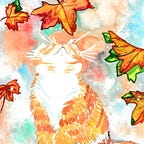Louhi Witch Goddess In Finnish Mythology
Louhi´s origins are most likely in the Saami goddesses who were connected to life, death, power of the moon and the divine feminine. Louhi is also known as Loviatar. The name Loviatar comes from the Finnish expression langeta loveen which is a state where shaman falls into trance. Another origin of her name is the old Finnish word lovi meaning door, entry and vagina. Louhi´s magic and connection to the moon and wolves represented the independent nature of women.
In the earliest myths of Uralic tribes, the first ruler of the underworld was a male waterbird. When culture became more patriarchal there were more suspicious qualities connected to the moon and towards women. Louhi became the goddess of the underworld.
This also meant a shift in the ways people saw the underworld. In the shamanic world view, Alinen the underworld was not like the Christian hell. It was a place where spirits waited their turn to be reborn. When Finnish mythos got more influences from other cultures and later on from Christianity, underworld became a place of all misery and torture. Louhi was demonized and became a presentation of the Christian devil. She was turned into an old hag who gave birth to all the evil things to this world: sicknesses, pain and death. In Lönnrot´s epic Kalevala Louhi is portrayed as the evil witch of the north.
Louhi shared her faith with several other witch goddesses around the world. She is the goddess of the seekers, fortune-telling and hidden knowledge. Louhi is connected to the moon, winter, north and her sacred animals are wolves, snakes, lizards and dragons. She represents freedom, independence, magic, intuition and self-trust.
Madderakka
The strong role of female deities in Finnish mythology can be found in the surrounding cultures as well (Baltic, Scandinavia and the Saami´s). In the Saami mythology, the most important deity of all was Madderakka the earth goddess and her three daughters Sarahkka, Juksakka and Uksakka. Madderakka was the goddess of women and was in charge of fertility and pregnancies. Her three daughters were all protectors of children and childhood. Madderakka was believed to be the earth itself. She was the protector of all life. It was believed that when a child was conceived, Madderakka received the soul of the child from Radien, the god of community and it was her job to attach the soul of the child to the body.
Sarakka
Sarakka was the protector goddess of women and many rites dedicated to her were only allowed for women. She was the goddess who lived in the hearth fire. Sarakka protected the pregnant woman and aided them in giving birth. Sacrifices in her honour were made before going into labour and after. Sarakka protected the woman throughout their whole life, from the moment of conception to old age. Her symbol was the snow grout.
Juksakka
Juksakka was the protector of men and boys. She was an archer goddess and the goddess of the hunt. If parents wished for a boy child they attached bow and arrows to the komsio (Saami baby basket/cradle).
Uksakka
Uksakka´s name means the woman of doors. She was the protector of entries. She was the midwife and delivered the child safely to the world. Uksakka protected the child from the day they were born until the day they moved away from home.
Subscribe to my channel: https://www.youtube.com/user/fairychamber
Get 1 Free Month Premium on Skillshare https://www.skillshare.com/r/user/niinaniskanen
If you enjoy reading my content, consider subscribing to my feed. Also, if you are not a Medium member and you would like to gain unlimited access to the platform, consider using my referral link right here to sign up. It’s $5 a month and you get unlimited access to my articles and many others like mine. Thanks.
